Thinning acrylic paint is a process that can be done in various ways, depending on the desired outcome.
In some cases, it might be necessary to thin out the acrylic paint to achieve a specific consistency or make it easier to work with.
In other cases, you might want to add thinner to create interesting and unique textures.
Many different types of thinners can be used for this purpose, and each one will produce a different effect.
So how do you thin acrylic paint? Let’s take a closer look!
How Do You Thin Acrylic Paint?
There are several ways to thin acrylic paint, one of the most common methods is adding water. This will usually result in a more translucent paint with a softer look. However, if you want to achieve a more opaque color, then using an acrylic binder or medium can be helpful.
What Does Thinning Acrylic Paint Mean?
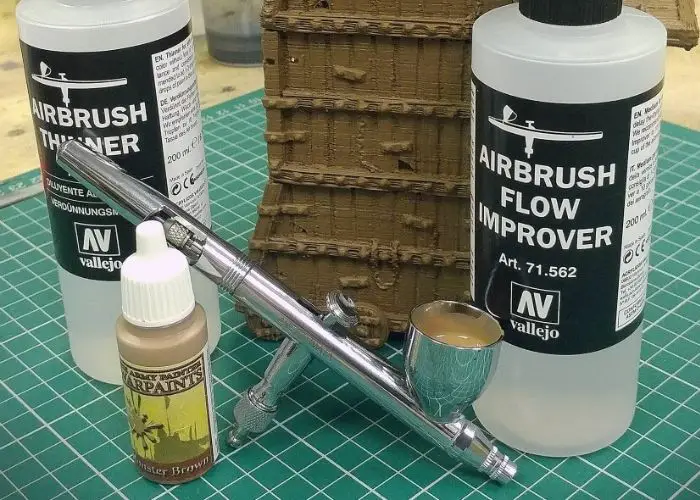
Thinning acrylic paint refers to the process of adding a liquid medium to the paint in order to change its consistency.
This can be done for a variety of reasons, such as making the paint easier to work with or creating interesting effects.
There are many different liquids that can be used for this purpose, including water, acrylic mediums, and even paint thinners.
Are You Supposed to Thin Acrylic Paint?
Why is my acrylic watery? There is no right or wrong answer to this question, as it depends on what you are trying to achieve with your painting.
In some cases, it might be necessary to thin the paint to get the desired consistency.
In other cases, you might want to leave the paint as is to maintain its thickness.
Ultimately, it is up to you to decide whether or not you want to make homemade acrylic paint thinner.
What To Use To Thin Acrylic Paint?
Many different liquids can be used for thinning acrylic paint, including water, acrylic mediums, and even paint thinners.
Each of these liquids will produce a different effect, so choosing the right one for your project is important.
Water: Water can be used to thin acrylic paint to create various effects. When added to the paint, water breaks down the paint pigments to make the it more fluid and easier to work with. It can also be used to create interesting textures and colors. Adding 30% of water to acrylic paint thins to a usable texture.
Acrylic Mediums: Acrylic mediums are a great option for thinning acrylic paint. They can be used to change the consistency of the paint without affecting its color or properties.
Paint Thinners: Paint thinners are a good choice for those who want to thin their paint without changing its color. However, it is important to note that paint thinners can also be used to remove paint from surfaces, so they should be used cautiously.
Various Ways of How to Thin Acrylic Paint
1. Thinning acrylic paint with water
Can I mix acrylic paint with water? Yes, you can. However, it’s important to note that acrylic paint is a water-based medium, so adding additional water will thin the paint and lower its pigment density.
That said, water can dilute acrylic paint for various purposes such as creating washes, increasing flow, and making cleanup easier.
Therefore, when using water to thin your paint, start with small amounts and gradually add more until you achieve the desired consistency.
Mixing acrylic paint with water
Here is a step-by-step process:
- Start with a small amount of water and add it to the paint until you achieve the desired consistency.
- If the paint is too thin, add more paint to thicken it.
- If the paint is too thick, add more water until it reaches the desired consistency.
- Always test your paint on scrap paper before applying it to your project.
2. Thinning with acrylic mediums
Acrylic mediums are a great option for thinning paint as they can change the consistency without affecting the color or properties.
Some popular choices include gesso, gel medium, and flow improver.
When using an acrylic medium, you will want to start with a small amount and gradually add more until you achieve the desired consistency.
Luckily for gesso, you can create the best gesso recipe with merely cornstarch or baking powder.
How to thin acrylic paint with acrylic mediums
Here is a step-by-step guide:
- Start with a small amount of the acrylic medium and add it to the paint.
- Gradually add more until you reach the desired consistency.
- If the paint is too thin, add more paint to thicken it.
- If the paint is too thick, add more of the acrylic medium until it reaches the desired consistency.
- Always test your paint on a scrap piece of paper before applying it to your project.
3. Thinning acrylic paint with an acrylic binder
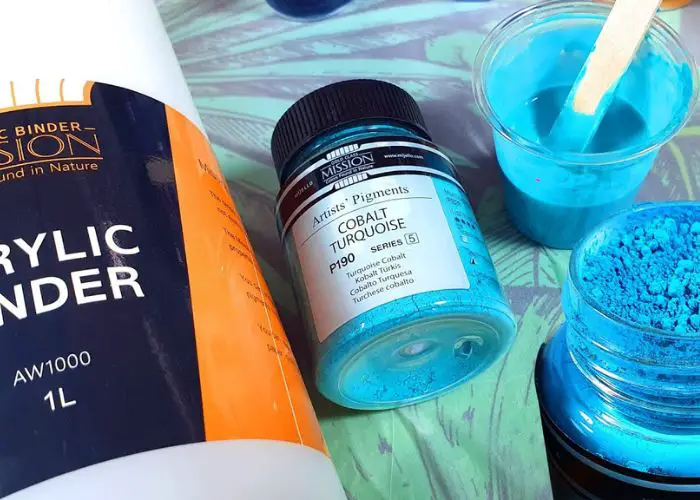
An acrylic binder is another great option for thinning paint. Like acrylic mediums, binders can change the paint’s consistency without affecting the color.
Some popular choices include glue, paste, and resin. When using an acrylic binder, you will want to start with a small amount and gradually add more until you achieve the desired consistency.
We recommend using PEBEO Studio Acrylics Auxiliaries, Bindex Acrylic Binder because it doesn’t yellow over time and produces a bright glossy look.
Read Also: Mixing Resin With Acrylic Paint
How to thin acrylic paint with an acrylic binder
Here is a step-by-step guide:
To thin acrylic paint with an acrylic binder, you will need:
- A small amount of the binder
- Your paint
- A container to mix the two
Step One: Start with a small amount of the binder. Then, add it to your paint and mix it.
Step Two: If the paint is still too thick, slowly add more binder until you achieve the desired consistency.
Step Three: Use your paint as normal.
As you can see, thinning acrylic paint with an acrylic binder is simple. And it’s a great way to change the consistency of the paint without affecting the color.
So if you’re looking for an alternative to water or mediums, try it!
4. Thinning acrylic paint with pouring medium
What is pouring medium?
A pouring Medium is a liquid that can be added to paint to change the viscosity, making it easier to pour.
There are a few different types of pouring mediums on the market, each with its own benefits. Some can be mixed with water, while others must be used straight from the bottle.
Pouring mediums can also be mixed with other mediums to create interesting effects. For example, you can add a glitter medium to create sparkly paintings or a flow medium to create cells.
If you’re new to pouring, we recommend starting with a pouring medium that can be mixed with water.
This will make it easier to control your paint’s consistency and avoid accidents! We recommend Pouring Masters Titanium White Acrylic.
How to thin acrylic paint with pouring medium
Here is a step-by-step guide on how to thin acrylic paint with a pouring medium:
- Start by adding a small amount of pouring medium to your paint. You can add more if needed, but it’s always best to start with less and add more.
- Stir the paint and pouring medium together until they are combined.
- Test the consistency to see if the thinned acrylic paint suits you. If not, add more pouring medium and stir again.
- Your paint is ready to use once you have reached the desired consistency!
5. Thinning acrylic paint with spirits and paint thinners
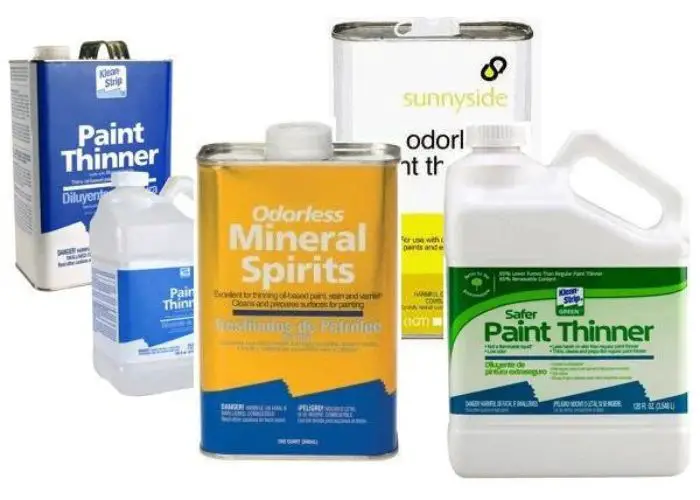
Paint thinners and spirits can also be used to thin acrylic paint. However, these materials should be used sparingly as they can alter the color of your paint.
If you choose to use spirits or paint thinners, we recommend adding them a little at a time until you reach the desired consistency.
You should also be aware that these materials may make your paint dry faster, so be sure to work quickly when using them.
Try the U.S. Art Supply 16-Ounce Pint Airbrush Thinner and U.S. Art Supply Odorless Mineral Spirits Thinner for the best results
Key takeaways:
- There are a few different ways to thin acrylic paint, including adding water or pouring medium.
- Paint thinners and spirits can also be used to thin acrylic paint, but they should be used sparingly as they can alter the color of your paint.
- When adding any liquids to your paint, start with a small amount and then add more if needed. This will help you avoid making your paint too thin.
Can You Thin Acrylic Paint with Alcohol?
Yes, you can thin acrylic paint with alcohol. However, there are a few things you need to keep in mind when doing so.
First, ensure you use high-quality alcohol, such as vodka or denatured alcohol. These types of alcohol will not affect your paint color like cheaper alternatives.
Second, only add a small amount of alcohol to your paint at first. You can always add more if needed, but it’s difficult to take away once it’s been added.
Finally, mix your paint thoroughly after adding the alcohol to ensure that it is evenly distributed.
Recommended read: Difference between acrylic and poster paint
Can You Thin Acrylic Paint with Mineral Spirits?
Yes! Mineral spirits are a great solvent for acrylic paint and can be used to thin it out without affecting the color or quality of the paint.
Simply add a few drops of mineral spirits to your paint and stir until it reaches the desired consistency.
After painting with acrylics, you can also use mineral spirits to clean your brushes.
Make sure to rinse them well afterwards so that the mineral spirits don’t affect the next acrylic painting session.
Can you thin acrylic paint with water?
Yes, acrylic paint can be thinned with water. Simply add small amounts of water to acrylic paint until you achieve your desired consistency. Start with a 9:1 ratio of paint to water and adjust as needed.
Thinned acrylics are ideal for techniques like layering and glazing. However, for specific effects or longevity, consider acrylic mediums or flow improvers.
Can You Thin Acrylic Paint with Acetone?
Yes, you can thin acrylic paint with acetone. Acetone is a powerful solvent that can dissolve most types of paint, including acrylics.
However, it is also extremely flammable and should be used with caution. When using acetone to thin paint, always add the solvent to the paint, not the other way around.
In addition, be sure to work in a well-ventilated area and wear gloves and a respirator to protect yourself from fumes.
Can You Use White Spirit to Thin Acrylic Paint?
Yes. White spirit is a petroleum-based solvent used to thin oil-based paints and varnishes.
It can also be used to clean brushes and other painting equipment. However, there are some things you should know before using white spirit to thin your paint.
First of all, white spirit is highly flammable, so it’s important to use it in a well-ventilated area.
Secondly, it’s important to dilute the white spirit with water before adding it to your paint, as the undiluted solvent can damage some types of paint.
Finally, you should test the diluted solution on a scrap piece of paper before using it on your project, as it may affect the color or finish of your paint.
How to Thin Acrylic Paint for Pouring
Acrylic paint is a popular choice for pour painting because it is inexpensive and easy to work with.
But in order to get the best results for acrylic pouring, it is important to thin the paint properly.
The general rule of thumb is to add 2 parts paint to 1 part water. You can also use liquitex professional pouring effects for best results. (Here are some of the reasons why Liquitex is good).
However, this ratio may need to be adjusted depending on the type of paint you are using and the effect you are going for.
Experiment with different ratios to find the one that works best for you. Once your paint is thinned out, you can pour it onto your canvas and create beautiful works of art.
Who knows, maybe someday your paintings will hang in a gallery. But even if they don’t, as long as you enjoy the process, that’s all that matters.
How to Thin Acrylic Paint for Airbrush Technique
Airbrushing is a popular technique for painting models and miniatures, as it allows for very precise applications of paint.
However, To get the best results with an airbrush, it is important to thin the paint properly.
Acrylic paint is a good choice for airbrushing, as it dries quickly and can be easily thinned with water.
When thinning acrylic paint for airbrush use, it is important to add the airbrush thinners slowly and mix thoroughly.
Too much thinner will result in a runny paint that does not adhere well to the absorbent surface, while too little will make the paint too thick and difficult to spray evenly.
The best airbrush medium to use is the VALLEJO Airbrush Paint Thinner.
How to thin acrylic paint for spraying
To thin acrylic paint for spraying:
- Pour the desired amount of acrylic paint into a mixing container.
- Start by adding 10% water for every 90% of paint.
- Mix thoroughly until consistency is similar to milk.
- Check the consistency; if too thick, add more water in small increments.
- Test spray on a scrap material. Adjust if necessary.
- Always clean the spray equipment immediately after use to prevent clogging.
How to Thin Acrylic Paint for Walls
To thin acrylic paint for walls, mix one part of paint with one part of water. You can also add a drop or two of dish soap to help the paint spread more evenly.
If you’re using a brush, dip it in the mixture and tap it on a paper towel to remove any excess paint.
Next, begin painting in the center of the wall and work your way out. Use long, even strokes, and be sure to overlap each stroke by about half an inch.
When you’re finished, clean your brushes with soap and water. You may be asking yourself, will acrylic paint stick to concrete? Read to find out.
How to Thin Acrylic Paint for Fabric
There are a few different ways to thin acrylic paint for fabric. One approach is to add a flow aid such as water or glycerin.
Then, simply mix the flow aid with the paint until you achieve the desired consistency.
Another option is to use a thinner designed specifically for acrylic paint. This can be found at most art supply stores.
Finally, you can also add a retarder to the paint. This will slow down the drying time, making it easier to work with.
Whichever method you choose, test the paint on a scrap piece of fabric before applying it to your project.
How to Thin Acrylic Paint for Hydro Dipping
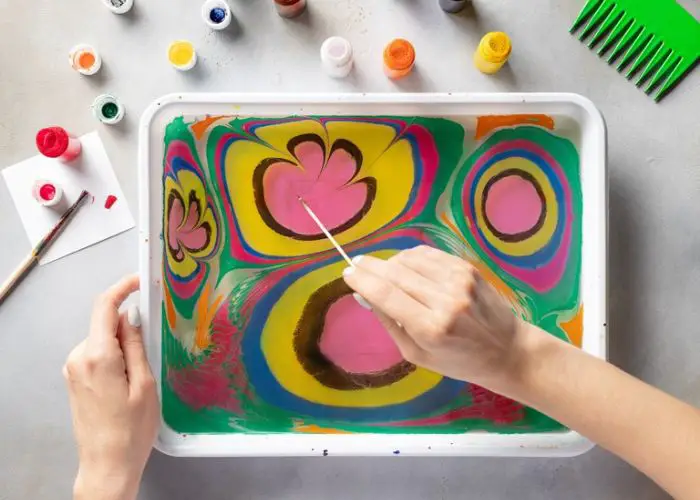
Hydro-dipping acrylic paint is the process of applying the paint to an object by submerging it in distilled water.
The paint clings to the object and creates a unique, three-dimensional design. To achieve the best results, it is important to use thinned paint.
Otherwise, the paint will not adhere properly, and the design will be lackluster. Here are some tips for thinning acrylic paint for hydro dipping:
- Start with high-quality acrylic paint. This will make it easier to achieve a consistent color and prevent the paint from peeling.
- Mix the paint with water at a ratio of 1:1.
- Add more water to the mixture if you want a more transparent effect.
- Stir the mixture thoroughly until there are no lumps and the color is evenly distributed.
- Once you have achieved the desired consistency, dip your object into the water and enjoy your new creation!
How to Thin Acrylic Paint for Wood
Applying a fresh coat of paint is a great way to give wood a new lease on life.
However, before you start painting, it’s important to know how to thin your acrylic paint for the best results.
Otherwise, you may end up with a runny mess that doesn’t adhere to the surface properly.
Thinning your paint is also essential if you’re planning on using a sprayer, as this will help to prevent clogging.
The good news is that thinning acrylic paint is relatively simple. All you need is water and a paint stirrer.
Start by adding a small amount of water to your paint and stirring it gently until the desired consistency is achieved.
Remember that you can always add more water if needed, but you can’t take it out once it’s mixed in.
How to Thin Acrylic Paint for Canvas
Acrylic paint is a versatile medium that can be used for a variety of projects. However, if you’re planning on using it for a canvas painting, you’ll need to thin the paint first.
Here’s how to do it:
- Start by pouring some acrylic paint into a cup or bowl. Then, add an equal amount of water to the paint and stir gently until the two are combined.
- Next, take a clean brush and dip it into the thinned paint. Once you’ve done that, start painting your canvas in smooth, even strokes.
- If the paint is too thin or runny, add more paint to the mixture. On the other hand, if the paint is too thick, add a bit more water until you reach the desired consistency.
Which are the Best Acrylic Paint Thinners?
The best acrylic paint thinners will depend on your personal preferences and the project you’re working on.
Water is a good option if you’re looking for a general-purpose thinner. However, if you need something that will dry faster, consider using an acrylic binder or retarder.
Also, try adding a pouring medium to your paint for projects requiring more transparency.
Finally, if you’re having trouble with brushstrokes, consider using a flow aid such as glycerin.
Whichever thinner you choose, test it on a scrap piece of fabric before using it on your project.
1. Liquitex 5321 Professional Matte Gel Medium
- Dries translucent with a satin/matte finish; Viscosity and body similar to Liquitex Heavy Body Paint
- Lightweight, non-toxic; Translucent when wet, transparent when dry
- Includes 8-oz / 237ml jar of medium
This fluid additive is designed to improve the paint flow and leveling.
It can also be used to reduce brush strokes and increase transparency.
2. Winsor & Newton Sansodor Low Odor Solvent
- A low odor solvent which evaporates slowly, increases blending time and is suitable for thinning oil colors and cleaning brushes
- Suitable for oil and alkyd color
- Well suited to artists who prefer to avoid exposure to turpentine
Winsor & Newton Sansodor Paint Thinner is a petroleum distillate used to thin oil-based paints, varnishes, and lacquers.
This thinning medium can also clean brushes and other painting tools.
Sansodor Paint Thinner is non-toxic, biodegradable, and contains no harmful solvents.
3. Liquitex Professional Effects Medium
- A fluid medium incorporating an acrylic polymer with high resin solids.
- Creates even puddles, poured sheets, and flowing applications of color.
- Mix with Soft Body Acrylic Color to promote drying with a smooth even colored film.
Liquitex Pouring Medium is a versatile additive to thin acrylic paint or create translucent washes.
It also helps to improve the paint’s flow and leveling, making it perfect for abstract painting and pour techniques.
Pouring medium can be added to any type of acrylic paint, but it is most commonly used with liquid acrylics.
4. Golden Fluid Acrylics Binder
- COLOR DESCRIPTION: Named after British painter William Payne, early formulas contained indigo, alizarin lake, and ivory black. Today more commonly a mixture of ultramarine blue and black, it is considered easier to control and less intense than black as a mixing color.
- COLOR ATTRIBUTES: ASTM Lightfastness I (Excellent). Semi-Transparent. Pigment(s): PB29 (Polysulfide of Sodium-Alumino-Silicate), PBk7 (Nearly Pure Amorphous Carbon). Vegan.
- VERSATILITY – Blends easily with all acrylic colors, and readily tint gels, mediums, gessoes, and grounds, making them extremely versatile for various techniques including fine brushwork, glazing, staining, water media techniques, and more
This fluid acrylic binder is designed to increase the transparency and flow of your paint.
It can also create glazes, washes, and other effects.
In addition, Golden Fluid Acrylics Binder is non-toxic and does not contain any harmful solvents.
5. Createx Colors 4012 High-Performance Reducer
- A premium reducer for thinning water-based paint. Allows for decreased drying and curing times as well as improved flow with less tip-dry
- Mix with paint in any ratio to achieve desired viscosity and transparency. Non-reactive
- For use with all Createx Colors paints. Store paint bottles air-tight after mixing
Createx Colors 4012 is a versatile additive that can be used to thin acrylic paint or create translucent washes.
It also helps to improve the paint’s flow and leveling, making it perfect for abstract painting and pour techniques.
Pouring medium can be added to any type of acrylic paint, but it is most commonly used with liquid acrylics.
Which One Should You Use?
The best thinner for you will depend on the project you’re working on and your personal preferences.
Water is a good option if you’re looking for a general-purpose thinner. However, if you need something that will dry faster, consider using an acrylic binder or retarder.
Try adding a pouring medium to your paint for projects requiring more transparency.
Finally, if you’re having trouble with brushstrokes, consider using a flow aid such as glycerin.
Acrylic paint thinner recipe
Here’s how to make acrylic paint thinner;
Materials:
- Acrylic paint
- Distilled water or tap water (for basic thinning)
- Acrylic medium (optional, for maintaining paint’s integrity)
- Flow improver (optional, for reducing brush strokes or improving flow)
Steps:
- Begin by pouring the desired amount of acrylic paint into a mixing container.
- If using just water: Start by adding a small amount, usually a ratio of 9 parts paint to 1 part water.
- If using an acrylic medium: Mix equal parts of acrylic medium and water to create a 50/50 solution. Then add this mixture to your paint in small increments, stirring well after each addition.
- If using a flow improver: Add just a few drops at a time, as it’s potent. Mix well.
- Continually check the paint’s consistency. For spray applications, you’re aiming for a milk-like consistency.
- Always test your thinned paint on a scrap material to ensure it meets your needs before applying to your final surface.
Related Read: How to Make Cheap Acrylic Paint More Opaque
FAQs
What do you do if acrylic paint is too thick?
If the paint is too thick, add a bit more water until you reach the desired consistency.
What do you do if acrylic paint is too thin?
If the paint is too thin or runny, simply add more paint to the mixture but not too much paint.
What do you add to acrylic paint to make it flow?
Several flow aids can be added to acrylic paint, including glycerin, honey, and silicone.
Can you use hair spray to thin acrylic paints?
Hair spray can thin out acrylic paint, but it’s not the best option. The chemicals in hair spray can damage the paint and brushes. Instead, opt for a water-based thinner.
Can you use nail polish remover to thin acrylic paint?
Nail polish remover can thin out acrylic paint, but it’s not the best option. The chemicals in nail polish remover can damage the paint and brushes. Instead, opt for a water-based thinner for your thinning process.
How do you make acrylic paint spread easier?
There are several ways to make acrylic paint spread easier, including adding a flow aid or using an acrylic paint thinner.
Read also: How do you paint over gloss enamel with acrylics?
What is the best way to thin out acrylic paint?
The best way to thin out acrylic paint will depend on the project you’re working on and your personal preferences. Water is a good option if you’re looking for a general-purpose thinner. You can also use acrylic mediums, an acrylic binder, spirits, paint thinners, or paint conditioner.
How to thicken up acrylic paint
The best way to thicken up acrylic paint is to add a thickening agent, such as gesso, to the mixture. So, what does gesso do? Gesso is a type of acrylic painting primer that is often used to thicken up acrylic paint and give it a more opaque finish. Add other thickening agents, such as white glue or flour, to your paint mixture. These ingredients will make your paint thicker and easier to work with.
How to soften hardened acrylic paint
One way is to mix the hardened paint with a thinner, such as water or acetone. This will create a workable consistency that will slow down the drying process. Another way to soften hardened paint is to heat it up. This can be done with a heat gun or by putting the paint in a sunny spot. The heat will make the paint pliable again, so you can continue working with it.
How to thin acrylic paint for tie dye
To tie-dye with acrylic paint, you’ll need to thin the paint first. Add water gradually until you achieve the desired consistency for tie-dyeing wood or fabric. Experiment with different dilutions to create unique and vibrant tie-dye patterns using acrylic paint on your chosen surface.
Conclusion
This blog post has looked at how to thin acrylic paint and the different types of thinner that can be used. We have also looked at some FAQs about thinning acrylic paints.
The best way to thin out acrylic paint will depend on the project you’re working on and your personal preferences, but water is a good general-purpose option.
You can also use acrylic paint mediums, an acrylic binder, or spirits and paint thinners. Thanks for reading!

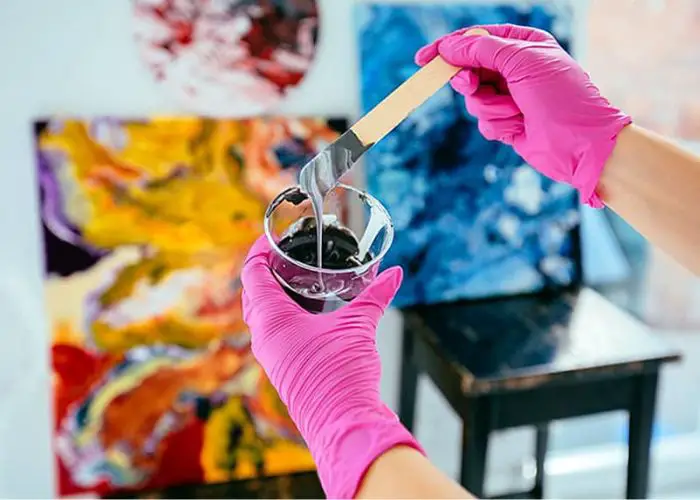














Leave a Reply